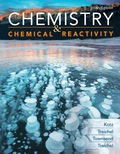
Chemistry & Chemical Reactivity
10th Edition
ISBN: 9781337670418
Author: Kotz
Publisher: Cengage
expand_more
expand_more
format_list_bulleted
Concept explainers
Question
Chapter 25, Problem 52PS
Interpretation Introduction
Interpretation:
The particle that is bombarded to Uranium–238 to form Californium–246 has to be determined.
Concept Introduction:
Balancing nuclear reaction equation: The balanced nuclear reaction should conserve both mass number and atomic number.
- The sum of the mass numbers of the reactants should be equal to the sum of mass numbers of the products in the reaction.
- The sum of
atomic numbers (or the atomic charge) of the reactants should be equal to the sum of atomic numbers (or the atomic charge) of the products in the reaction.
The Trans uranium elements are the chemical elements with atomic numbers greater than 92.All of these elements are unstable and decay radioactively in to other elements.
Expert Solution & Answer
Want to see the full answer?
Check out a sample textbook solution
Students have asked these similar questions
A partir de Aluminio y Co(NO3)2ꞏ6H2O, indicar las reacciones a realizar para obtener Azul de Thenard (Al2CoO4).
To obtain Thenard Blue (Al2CoO4), the following reaction is correct (performed in an oven):Al(OH)3 + Co(OH)2 → Al2CoO4 + 4 H2O
Problem 38 can u explain and solve thanks april 24
Chapter 25 Solutions
Chemistry & Chemical Reactivity
Ch. 25.2 - Prob. 25.1CYUCh. 25.2 - Prob. 25.2CYUCh. 25.3 - Prob. 25.3CYUCh. 25.3 - Prob. 25.4CYUCh. 25.4 - Prob. 25.5CYUCh. 25.4 - Prob. 25.6CYUCh. 25.4 - Prob. 25.7CYUCh. 25.5 - Prob. 25.8CYUCh. 25.8 - Prob. 25.9CYUCh. 25.8 - Prob. 1.1ACP
Ch. 25.8 - Prob. 1.2ACPCh. 25.8 - Prob. 1.3ACPCh. 25.8 - Calculate the molar mass (atomic weight) of...Ch. 25.8 - Prob. 2.1ACPCh. 25.8 - Prob. 2.2ACPCh. 25.8 - Prob. 2.3ACPCh. 25.8 - Prob. 2.4ACPCh. 25.8 - Prob. 2.5ACPCh. 25.8 - Prob. 2.6ACPCh. 25.8 - Prob. 3.1ACPCh. 25.8 - Prob. 3.2ACPCh. 25.8 - Prob. 3.3ACPCh. 25.8 - Prob. 3.4ACPCh. 25 - Prob. 1PSCh. 25 - Prob. 2PSCh. 25 - Prob. 4PSCh. 25 - Prob. 5PSCh. 25 - Prob. 6PSCh. 25 - Prob. 7PSCh. 25 - Prob. 8PSCh. 25 - Prob. 9PSCh. 25 - Prob. 10PSCh. 25 - Prob. 11PSCh. 25 - Prob. 12PSCh. 25 - Prob. 13PSCh. 25 - Prob. 14PSCh. 25 - Prob. 15PSCh. 25 - Prob. 16PSCh. 25 - Prob. 17PSCh. 25 - Prob. 18PSCh. 25 - Prob. 19PSCh. 25 - Prob. 20PSCh. 25 - Prob. 21PSCh. 25 - Prob. 22PSCh. 25 - Prob. 23PSCh. 25 - Prob. 24PSCh. 25 - Prob. 25PSCh. 25 - Prob. 26PSCh. 25 - Prob. 27PSCh. 25 - Prob. 28PSCh. 25 - Prob. 29PSCh. 25 - Prob. 30PSCh. 25 - Prob. 31PSCh. 25 - Prob. 32PSCh. 25 - Prob. 33PSCh. 25 - Prob. 34PSCh. 25 - Prob. 35PSCh. 25 - Prob. 36PSCh. 25 - Prob. 37PSCh. 25 - Prob. 38PSCh. 25 - Prob. 39PSCh. 25 - Prob. 40PSCh. 25 - Prob. 41PSCh. 25 - Prob. 42PSCh. 25 - Prob. 43PSCh. 25 - Prob. 44PSCh. 25 - Prob. 45PSCh. 25 - Prob. 46PSCh. 25 - Prob. 47PSCh. 25 - Prob. 48PSCh. 25 - Prob. 49PSCh. 25 - Prob. 50PSCh. 25 - Prob. 51PSCh. 25 - Prob. 52PSCh. 25 - Prob. 53PSCh. 25 - Prob. 54PSCh. 25 - Prob. 55PSCh. 25 - Some of the reactions explored by Ernest...Ch. 25 - Prob. 57GQCh. 25 - Prob. 58GQCh. 25 - Prob. 59GQCh. 25 - Prob. 60GQCh. 25 - Prob. 61GQCh. 25 - Prob. 62GQCh. 25 - Prob. 63GQCh. 25 - Prob. 64GQCh. 25 - Prob. 65ILCh. 25 - Prob. 66ILCh. 25 - Prob. 67ILCh. 25 - Prob. 68ILCh. 25 - Prob. 69ILCh. 25 - Prob. 70ILCh. 25 - Prob. 71SCQCh. 25 - Prob. 72SCQCh. 25 - Prob. 73SCQCh. 25 - Prob. 74SCQCh. 25 - Prob. 76SCQCh. 25 - Prob. 77SCQCh. 25 - Prob. 78SCQCh. 25 - Prob. 79SCQ
Knowledge Booster
Learn more about
Need a deep-dive on the concept behind this application? Look no further. Learn more about this topic, chemistry and related others by exploring similar questions and additional content below.Similar questions
arrow_back_ios
SEE MORE QUESTIONS
arrow_forward_ios
Recommended textbooks for you
 Chemistry: The Molecular ScienceChemistryISBN:9781285199047Author:John W. Moore, Conrad L. StanitskiPublisher:Cengage Learning
Chemistry: The Molecular ScienceChemistryISBN:9781285199047Author:John W. Moore, Conrad L. StanitskiPublisher:Cengage Learning Chemistry & Chemical ReactivityChemistryISBN:9781337399074Author:John C. Kotz, Paul M. Treichel, John Townsend, David TreichelPublisher:Cengage Learning
Chemistry & Chemical ReactivityChemistryISBN:9781337399074Author:John C. Kotz, Paul M. Treichel, John Townsend, David TreichelPublisher:Cengage Learning Chemistry & Chemical ReactivityChemistryISBN:9781133949640Author:John C. Kotz, Paul M. Treichel, John Townsend, David TreichelPublisher:Cengage Learning
Chemistry & Chemical ReactivityChemistryISBN:9781133949640Author:John C. Kotz, Paul M. Treichel, John Townsend, David TreichelPublisher:Cengage Learning Principles of Modern ChemistryChemistryISBN:9781305079113Author:David W. Oxtoby, H. Pat Gillis, Laurie J. ButlerPublisher:Cengage Learning
Principles of Modern ChemistryChemistryISBN:9781305079113Author:David W. Oxtoby, H. Pat Gillis, Laurie J. ButlerPublisher:Cengage Learning Chemistry for Today: General, Organic, and Bioche...ChemistryISBN:9781305960060Author:Spencer L. Seager, Michael R. Slabaugh, Maren S. HansenPublisher:Cengage Learning
Chemistry for Today: General, Organic, and Bioche...ChemistryISBN:9781305960060Author:Spencer L. Seager, Michael R. Slabaugh, Maren S. HansenPublisher:Cengage Learning

Chemistry: The Molecular Science
Chemistry
ISBN:9781285199047
Author:John W. Moore, Conrad L. Stanitski
Publisher:Cengage Learning

Chemistry & Chemical Reactivity
Chemistry
ISBN:9781337399074
Author:John C. Kotz, Paul M. Treichel, John Townsend, David Treichel
Publisher:Cengage Learning

Chemistry & Chemical Reactivity
Chemistry
ISBN:9781133949640
Author:John C. Kotz, Paul M. Treichel, John Townsend, David Treichel
Publisher:Cengage Learning

Principles of Modern Chemistry
Chemistry
ISBN:9781305079113
Author:David W. Oxtoby, H. Pat Gillis, Laurie J. Butler
Publisher:Cengage Learning


Chemistry for Today: General, Organic, and Bioche...
Chemistry
ISBN:9781305960060
Author:Spencer L. Seager, Michael R. Slabaugh, Maren S. Hansen
Publisher:Cengage Learning